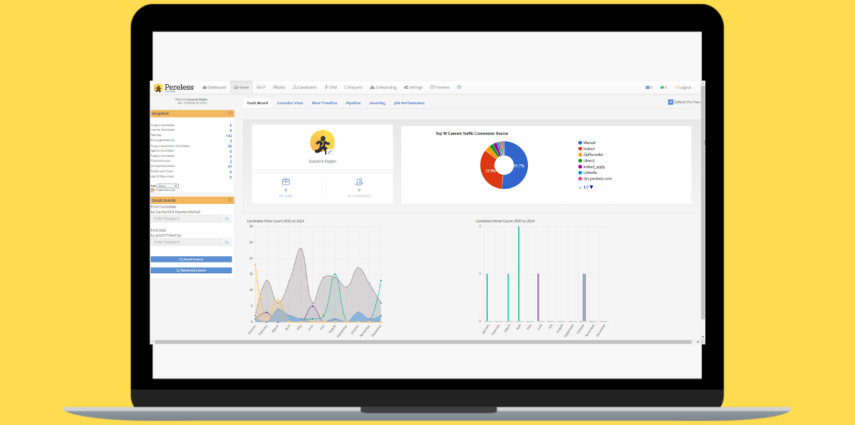How AI Will Affect Recruitment in the Future
The recruitment landscape is rapidly evolving, with artificial intelligence (AI) set to play a transformative role in how companies attract, evaluate, and hire talent. Here are the primary impacts AI will have on recruitment:
1. Automated Resume Screening and Candidate Sourcing
AI-driven systems can automatically screen resumes and profiles, quickly matching candidates with job requirements. Advanced Natural Language Processing (NLP) algorithms can understand qualifications, skills, and experiences beyond keywords, making initial filtering more efficient and unbiased.
• Impact: Recruiters can save time by focusing on the most relevant candidates, reducing bias through objective filtering.
2. Enhanced Candidate Matching
AI-powered tools can go beyond resume parsing to include candidate soft skills, cultural fit, and potential for growth. By leveraging predictive analytics and machine learning models, these systems can recommend the best-fit candidates for each role, boosting the quality of hires.
• Impact: This approach increases precision in matching job seekers with positions, reducing turnover rates and improving employee satisfaction.
3. Automated Communication and Candidate Engagement
Chatbots and AI-driven communication tools can handle initial interactions, answer candidate queries, schedule interviews, and keep applicants updated. This enhances the candidate experience by ensuring continuous engagement throughout the recruitment process.
• Impact: Streamlined communication reduces delays and improves candidate satisfaction, ensuring a positive employer brand image.
4. Data-Driven Insights and Predictive Analytics
AI can analyze large volumes of recruitment data to identify patterns and trends. Companies can use these insights to forecast hiring needs, adjust recruitment strategies, and optimize job descriptions to attract high-quality candidates.
• Impact: Improved data analysis leads to more strategic decision-making and better talent pipeline management.
5. AI-Enhanced Interviews and Skill Assessments
AI-powered tools such as facial recognition and voice analysis can be used during video interviews to assess emotions, confidence, and honesty. Additionally, skill assessments powered by AI can evaluate hard skills through simulation-based testing or gamified evaluations.
• Impact: Interview analysis increases objectivity in the hiring process, while skill-based assessments offer a more accurate gauge of candidate capabilities.
Types of Software Firms in the HR Sector that Will Benefit
The growth of AI in recruitment will benefit several types of HR tech companies. These firms focus on various aspects of talent acquisition, management, and employee engagement:
1. Recruitment Software and Applicant Tracking Systems (ATS) Providers
Firms offering ATS with AI integration will benefit greatly. These systems can utilize machine learning for resume parsing, job matching, and predictive hiring analytics. Companies like Greenhouse, Lever, and Workday have already started integrating AI features into their solutions.
2. AI-Powered Talent Assessment and Screening Platforms
Companies specializing in candidate assessments and screening tools will see increased demand. Platforms like Pymetrics, HireVue, and Codility use AI to assess candidates based on cognitive, emotional, and technical skillsets.
3. Chatbot and Candidate Engagement Platforms
Firms creating conversational AI tools like chatbots for candidate engagement and initial screening will be at the forefront. Examples include Mya Systems, Paradox (Olivia), and AllyO.
4. Video Interview and Analysis Software
Companies offering AI-enhanced video interviewing solutions, such as HireVue and XOR, will benefit. These platforms can analyze candidates’ facial expressions, voice modulation, and speech patterns, adding another dimension to interview evaluations.
5. HR Analytics and Predictive Analytics Firms
Firms focusing on predictive hiring and HR analytics will benefit as businesses rely on AI insights for strategic workforce planning. Companies like Eightfold AI and Visier use data-driven models to predict hiring needs and analyze talent gaps.
6. Employee Onboarding and Experience Platforms
Companies that provide AI-based onboarding and employee experience solutions, like Talmundo or Enboarder, will see significant growth. AI can help customize the onboarding journey, ensuring a more personalized employee experience.
Take Away
The recruitment industry stands to be significantly transformed by AI. The combination of automated resume screening, candidate matching, predictive analytics, and AI-enhanced assessments is set to reshape how organizations source and hire talent. Software firms in the human resource sector focusing on AI-driven solutions, candidate engagement, predictive analytics, and tailored experiences will be well-positioned to capitalize on these trends.
Are you hiring for the upcoming holiday season? Let Pereless Systems help assist you in streamlining your recruiting process and attract top talent fast! With job board integrations to Indeed, ZipRecruiter, LinkedIn, etc. Pereless Systems will find you top qualified candidates in no time! Request a demo today and see how we can help you simplify hiring!
The Future of Recruiting: Adapting to Change with AI and Technology November 1st, 2024Pereless


